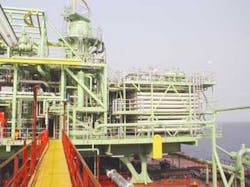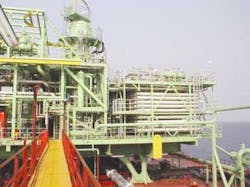Deepwater project economics demand sulfate removal to ensure scale-free operation
Chemical inhibitors expensive, difficult to apply
John E. McElhiney
Pratt Technology Management
In the early 1980s, Marathon Oil Co. UK began development of the Brae field complex in the North Sea. High concentrations of barium (1,500 – 2,000 mg/l) were discovered in the reservoir formation water, and seawater injection for pressure maintenance was likely.
At that time, no scale inhibitors existed that were effective or affordable at these elevated barium concentrations. Marathon engineers and chemists began searching for a technology that would provide help in this challenging sulfate-scaling situation. Determining that removing sulfate from the injected seawater eliminates the source of scaling, Marathon conceived and patented a membrane process.
null
The process successfully reduced sulfate concentrations in seawater used for injection by over 99%. In collaboration with Dow Chemical Co., Marathon developed and first tested the required membrane in a pilot application of sulfate removal technology at Brae in 1988. After a short test period, a membrane plant capable of treating 120,000 b/d of injection water was built and retrofitted to the Brae Alpha platform. The plant has been used since then.
Three generations of membrane improvements have:
- Improved temperature stability
- Improved efficiency by increasing the surface area of each membrane element by 25%
- Reduced sulfate concentrations in the injected stream to < 40 mg/l.
As a result, cost savings of 50% or more compared to the original Brae plant have been realized.
Through the 1990s, three additional low sulfate seawater (LSSW) plants were built and licensed to other oil operators in the North Sea. The plants have provided protection against calcium, strontium, and barium sulfate scales. Historical performance has shown the process to be commercially and technically viable.
Chemical squeeze inhibition
Historically, chemical squeeze inhibition (CSI) technology has been used with dry wellheads and simple downhole completions. With CSI, aqueous solutions of inhibitors are bullheaded down producing wells; the inhibitor is "squeezed" into the producing formation and adsorbs onto the reservoir rock where it slowly desorbs later into produced water.
Barium concentrations manageable with CSI are directly impacted by the complexity of the well completion. With dry wellheads and downhole completions where zone isolation is possible, CSI is often used when Ba++ < 200 mg/l. With more complex completions such as downhole laterals and/or slotted liners where zone isolation is not possible, CSI may not be useful when Ba++ > 25 mg/l.
CSI is often the method of choice for application downhole from dry wellheads for a variety of reasons. Principal among these are that it is easy to apply and it isn't required until later in the waterflood pro-cess when water-cuts increase.
The drawbacks of CSI include downtime of producers to inject the chemicals, diminished oil production after injecting aqueous solutions into highly oil saturated producing zones, and the risk of loss or damage to production wells. Drawbacks of CSI specific to deepwater applications are that tiebacks incorporate multiple wells, complicating or making single bullheaded well treatments impossible. In many cases, placement of CSI can be accomplished only through the use of expensive day-rental workboats, and multiple treatments are often required.
Low sulfate seawater
The LSSW process for controlling scale build-up is fundamentally different from the CSI process in that this approach removes sulfate from injection waters at the surface prior to injection. The process can in effect be considered to be "treating" the injection wells rather than the producing wells. The enabling technology for the LSSW is Marathon's patented SRT and employs proprietary membranes that selectively lower sulfate concentrations found in injection waters to < 40 mg/l, thereby removing the sulfate that reacts with barium, strontium, or calcium found in formation waters.
In deepwater projects, LSSW is the method of choice for scale control. The principal reasons for this choice are:
- Producing wellheads are subsea and distant from FPSOs or other producing facilities
- Gathering lines that often connect multiple wells prevent proper inhibitor placement and monitoring
- Completions are often multi-lateral, with no downhole zone isolation control. In addition, LSSW plants sit on the decks of FPSOs, or other producing facilities, where they can easily be maintained.
Potential drawbacks to LSSW are that LSSW must be injected at the time of waterflood initiation, necessitating early investment, and LSSW plants, particularly retrofits, are sometimes difficult to locate because of space and weight considerations.
Economics model
The basis for comparison of LSSW vs. CSI in all cases is an oilfield prototype economics spreadsheet containing 20 wells, each producing 10,000 b/d of fluids. At the outset, production is dry oil with a decline rate of 7.5% per year. Waterflooding for pressure maintenance begins in the first year at the full rate of 200,000 b/d LSSW.
The reservoir is assumed to have balanced voidage, i.e., for each barrel of declining oil production a barrel of water will be produced. In this model, the water cut after 12 years is 70%, and it is assumed that the critical potential for scaling has been diluted with injected LSSW and no further sulfate scale protection is required.
The assumptions and costs for CSI have been taken directly from an industry paper published in 2002, plus the frequency of CSI application. The chemical costs, only of a pre-emptive CSI, are applied to each well at the outset of production, and repetitive CSIs are assumed to begin in year three when the water-cut is 15% in all cases. The oil production lost from CSI deployment is deferred to year 13 in all cases and discounted accordingly at 15%.
The capital construction costs for the LSSW plant are $35 per b/d plus 25% for installation cost. Adding membrane costs brings the total capex for LSSW to $60 per b/d. For the 200,000-b/d plant the total capex is $12 million. These capex charges are about 50% of those required for the original Brae plant. The operating cost of the membrane plant is ~$.05/BW injected. Complete membrane replacement is assumed every three years.
Oil prices of $15/bbl and $25/bbl are used. The net present value (NPV) of the cash flow stream of costs, discounted at 15% and divided by the total barrels of produced water is used as the basis for comparison for the two processes. It should be noted that the cost of LSSW is independent of oil price and water depth/completion type, i.e., the cost of LSSW is invariant between cases.
Economic cases
The following compares CSI and LSSW in three cases:
- Dry wellheads where CSI is bullheaded downhole
- Shallow water developments with subsea wellheads where CSI is placed with coiled tubing from workboats
- Deepwater developments with subsea wellheads where CSI is placed with coiled tubing from workboats.
For these cases, shallow water is less than 1,000 ft and deepwater is more than 3,000 ft.
For cases 2 and 3, CSI frequencies of one and two years are both examined. In all cases, the same LSSW plant is in place either on a platform or on an FPSO. No allocation to capex for floor space for an LSSW plant is included, nor are any deferred oil production charges taken for failure of production wells to return to full production after CSI is applied. No workover charges for damaged wells resulting from incompatible CSI treatments are included.
The total discounted cost for the $25/bbl oil cases indicated LSSW costs $0.112/bbl of water produced ($0.037/bbl of LSSW injected) and was insensitive to both oil price and producing scenario. For the bullheaded case, CSI and LSSW cost are very nearly the same with a slight edge to CSI. For the deepwater cases, CSI costs $1.279-2.719/bbl of produced water, depending both upon oil price and CSI frequency, thus LSSW is less costly by an order of magnitude. A recent publication confirms this conclusion for deepwater projects.
The NPV of discounted cost of CSI and LSSW for all cases was calculated. The contributions for costs of deferred oil production, and chemicals plus service to place the CSI treatment and the contributions of capex and opex to the total cost of LSSW were also analyzed. All costs used are in discounted dollars divided by the overall amount of water produced (284.58 MMbbl).
A slight anomaly occurs in the CSI cost comparison for deferred oil production between case 1a and case 2b (and between case 1b and case 2c) as the cost for deferred oil production is lower in cases 2b/c than in cases 1a/b. This difference results from the assumptions of CSI treatment frequency and the associated timing/discounting of the deferred oil.
Deferred oil production cost constitutes about 8-14% of the total CSI cost except in the bullheaded case, where it is 70%; the majority contributor to CSI costs is attributed to the cost of squeeze treatment. CSI is considerably more sensitive to squeeze frequency than to oil price, particularly for the subsea wellhead cases.
- From the standpoint of economics, LSSW is the clear-cut choice by an order of magnitude for sulfate scale control in deepwater projects where wellheads are subsea and completions are complicated
- CSI cost is directly impacted by the cost to access subsea wellheads
- The cost of deferring production in CSI treatments is 8-14% for subsea wellhead cases, and rises to 70% for bullheaded cases
- While the prototype model used here is rudimentary, more detailed modeling is not expected to reverse this finding.
Acknowledgements
The author thanks Marathon Oil Co. and Pratt Technology Management for permission to publish this paper. Thanks are also due to George P. Southwell of Pratt Technology Management, Brian Hodgson and Paul Gardner of Marathon Oil Co., Roy A. Davis of Dow Chemical Co., and Dr. Gordon Graham of Scaled Solutions Ltd.



